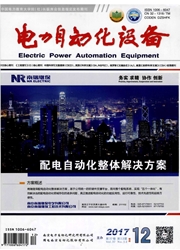

 中文摘要:
中文摘要:
由于微电网电气联系紧密,且低压线路阻抗比较大.其电压水平不仅与无功功率相关.也与有功功率密切相关。为此.建立了节点电压与有功功率的关系模型.推导了有功一电压灵敏度矩阵。针对微电网中电源逆变器一次电压控制的调节能力有限等问题.提出了一种微电网二次电压模糊控制策略。通过节点有功-电压灵敏度建模,考虑了网络拓扑的影响;基于模糊控制理论.建立了通过调节有功功率进行微电网实时电压控制模型,丰富了微电网电压控制的手段。算例分析表明:当微电网中线路电阻与电抗之比较大时.各节点电压受有功功率变化的影响较大。应对实时功率波动引起的电压偏离.除传统的无功控制策略之外.通过调节分布式电源的有功功率.也可以有效地将各节点电压控制在允许范围内.从而提高微电网的电压质量。
 英文摘要:
英文摘要:
Since the electrical connection of microgrid is closer and its LV(Low Voltage) line resistance is larger,its voltage level is closely related to both active-power and reactive-power. A relationship model between bus-voltage and active-power is built and the sensitivity matrix of bus-voltage to active-power is derived. Aiming at the limited regulation capacity of DG(Distributed Generation) converters in the primary voltage control of microgrid,a fuzzy control strategy is proposed for the secondary voltage control of microgrid. A sensitivity model of active-power to bus-voltage is built,which considers the influence of network topology. A real-time voltage control model based on fuzzy control theory is built,which adjusts the active-power of microgrid to enrich the means of microgrid voltage control. Case study shows that,if the resistance-reactance ratio of microgrid line is larger,the influence of active-power on the bus-voltage is larger too. In addition to the reactive-power control,the DG active-power adjustment can be used to effectively control the bus voltage within allowed range for enhancing the voltage quality of microgrid.
 同期刊论文项目
同期刊论文项目
 同项目期刊论文
同项目期刊论文
 期刊信息
期刊信息
